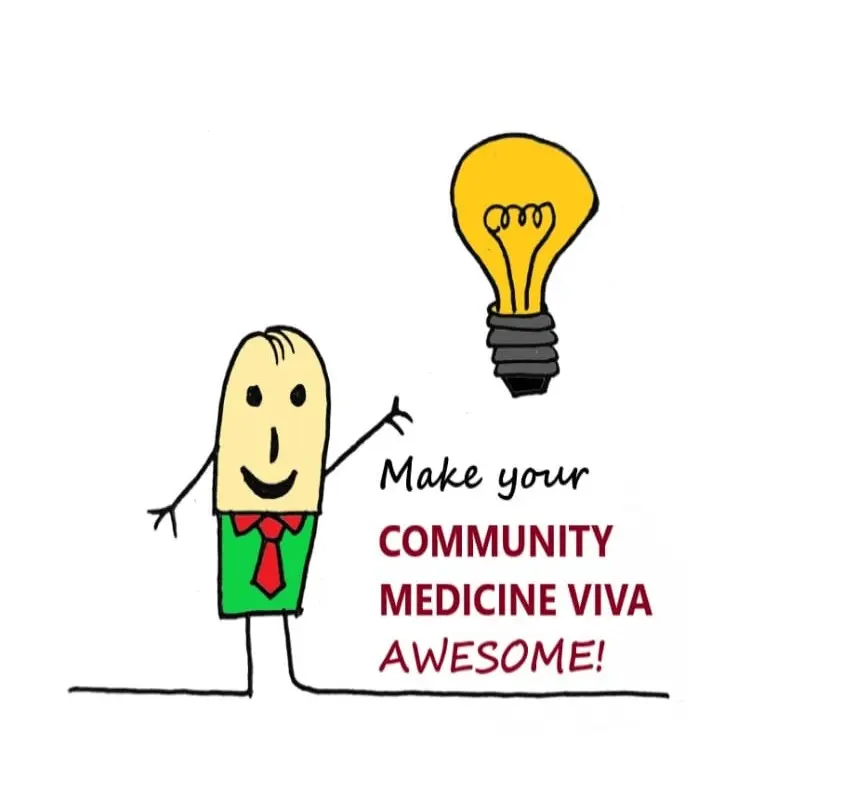
After reading for Theory examination, you are definitely preparing yourself for Viva and practical examination.
Here is good news for you that I have listed some points that should be remembered before appearing the Viva examination of Preventive and social medicine.
At this point I assume that you have been through our 4th BHMS COMMUNITY MEDICINE SYLLABUS already.
So, start summarising your whole subject and all the best for your viva exam.
- Benign tertian Malaria is caused by – Plasmodium vivax.
- Malignant Malaria by- Plasmodium falciparum
- In Benign Tertian Malaria fever comes every – 48 hours or 2 days.
- Incubation period of Malaria is – Usually 10 to 14 days (2 days for P. falciparum, 14 days for Pl. vivax and 30 days for P. Malariae).
- Incubation period of Cholera – Ranging from few hours to 1 or 2 days (of Diphtheria is 2 to 5 days).
- The insect louse carries- Epidemic typhus.
- Rate flea carries- Plague.
- Ascorbic acid deficiency causes- Scurvy.
- Retinol deficiency causes – Xerophthalmia, Xerosis
- Protein deficiency in infants causes – Marasmus.
- Retinol deficiency in infants causes – Night blindness, Xerophthalmia.
- Vitamin B1 deficiency produces –
- Vitamin D deficiency Leads to – Ricket.
- Acute Anterior Poliomyelitis is caused by – a group of related viruses viz Type 1 – Brunhilde, Type 2 – Lansing, Type 3 – Leon.
- Plague is caused by – Pasteurella Pestis.
- B., Diphtheria, Smallpox, Mumps etc are – Air borne diseases.
- Beriberi is – Due to Vitamin B1 deficiency.
- Protein deficiency causes – marasmus in children and anaemia in adults.
- Bubonic Plague is spread by – Infecting man through bite, wound or a minute existing abrasion of the skin.
- Pneumonic Plague is spread by – From man to man directly through the inhalation of throat secretions from the patients and the fomites.
- Malaria is caused by 4 types of pathogenic malaria parasite which are protozoa – Pl. Vivax, Pl. Falciparum, Pl. Malariae, Pl. Ovale.
- Cholera is caused by – Vibrio cholerae.
- Diphtheria is caused by – Corynebacterium diphtheriae (incubation period 2 to 5 days).
- Tuberculosis is caused by – Tubercle bacillus (incubation period 4 to 6 weeks).
- Leprosy is caused by – Mycobacterium Leprae.
- Syphilis is caused by – Spirochetes/ Treponema pallidum (incubation period 10 days to 10 weeks).
- Gonorrhoea is caused by – Neisseria gonococcus (incubation period 3 days to 3 weeks).
- Transmission of plague from rodents to man is caused by – Rat flea.
- Silicosis is – An occupational disease.
- Rabies is – Viral disease.
- Man is the – intermediate host in a case of Malaria.
- Endemic – When a disease is present at a low incidence throughout the year.
- Epidemic – Sudden occurrence of large number of cases within a short period in an area.
- International quarantinable diseases are – Smallpox, Cholera, Plague, COVID-19 19 etc.
- Benefits given by S.I. are – Sickness, Maternity, Disablement, Dependant, Medical.
- Levels of prevention are –
- Health promotion
- Specific protection
- Early diagnosis and treatment
- Disability limitation
- Common arthropod borne diseases in India are – Malaria, Kala-azar, Filaria etc.
- Common active immunizations are – B.C.G. against T.B.; TAB against Typhoid.
- Sexually transmitted diseases are – Gonorrhoea, Venereal syphilis.
- Social security measures are – Education, Health, Social security and production.
- Different methods of food adulteration are – Mixing, substitution, abstraction, concealing the quality, putting up decomposed foods for sale, misbranding or giving fails and addition of poisons etc.
- Vitamin A deficiency diseases are – Xerosis, Xerophthalmia, Night blindness, Respiratory infections, formation of phosphoric calculi etc.
- Methods of conception control are –
- Permanent: Vasectomy, Salpingectomy.
- Temporary: Safe period, Abstinence during postnatal period, Use of Condom, Coitus interruptus, Diaphragm, Jelly, Foam tablet, Sponge cervical cap, Oral pills.
- Different methods of purification of water are – Pounding or storage, Oxidation and settlement, Distillation, Boiling, Precipitation, Domestic filtration, Slow and Rapid sand filtration, Chlorination etc.
- National Health Programmes in India are –
- Malaria eradication programme
- Filaria control programme
- Small -pox eradication programme
- Family welfare programme
- Leprosy control programme
- STD control programme
- Water supply and sanitation programme etc.
- Soil borne disease are – Cholera, Enteric fever, Amoebic dysentery etc.
- Common causes of blindness in India are – Cataract, Trachoma, Infections of the eye, Smallpox, Malnutrition, Injuries, Glaucoma etc.
- Common causes of Maternal mortality in India are – Toxaemia of Pregnancy, Haemorrhage, Sepsis, Anaemia etc.
- Comprehensive health care is –
- Provision of integrated preventive, curative and promotional health services from “Womb to Tomb” to every individual residing in a defined geographic area.

50. Determinants of health are – Human biology, environment, Ways of living, Socio-economic status, health services.
51. Statistical average is calculated by – Vital statistics, health statistics, Demography etc.
52. Basic health services mean –
A network of coordinated peripheral and intermediate health units
↓
capable of performing effectively a selected group of functions
↓
essential to the health of an area and
↓
assuring the availability of component to perform these functions.
53. Primary health care means – The care given to the patient by the health worker who examined him first. It is also known as first contact.
54. Range or spectrum of Health are
- Positive health
- Freedom from sickness
- better health
55. Range or spectrum of Sickness are
- Mild sickness
- Unrecognised sickness
- Severe sickness
- death
56. Basic components of the level of living which is identified by Per Capita Income are – Health, Nutrition, Housing, Education, Employment, Working conditions, Clothing, Social security and human rights.
57. Five points for backwardness of family welfare are – Poverty, Disease, ignorance sequel or and idleness.
58. P.Q. L.I./ Physical Quality of Life Index indicates – The level of progress achieved by any country in meeting basic human needs. In India it was 41 in 1970.
59. Basic health problems in India are –
- Communicable disease problem
- Nutritional problem
- Medical care problem
- Environmental sanitation problem
- Population problem
- Educational problem
- Economical problem
60. Rural health Scheme in 1977 was based on the principle of – Placing people’s health in people’s hands.
61. Criteria of Sanitary Latrine are –
- Excreta should not contaminate the ground or surface water.
- Excreta should not pollute the soil
- Excreta should not be accessible to flies, rodents, animals and other vehicles of contamination.
- Excreta should not create a nuisance due to odour or unsightly appearance.
62. Vital events of life are Birth, Death and Marriage.
63. Early clinical signs of Vitamin A deficiency are – Night blindness, Xerophthalmia.
64. Cardinal features of pellagra – Dermatitis, Diarrhoea, Dementia.
65. Three important air borne viral diseases are – Measles, Mumps, Chicken-pox.
66. M.M.R. stands for – Maternal Mortality rate.
67. Oral rehydration fluid contains
- Sodium chloride: 3.5g
- Sodium bicarbonate: 2.5 g
- Potassium chloride: 15g
- Glucose/ Dextrose: 20 g
- Potable water: 1 litre
68. Dust borne diseases are – Anthracosis, Silicosis, Siderosis, Cancer lung, Asbestosis, Bagassosis, Byssinosis etc.
69. Components of under-five clinic are –
- Care of Illness
- Adequate nutrition
- Immunization
- Family planning
- Health education
70. Three types of carrier are – Incubatory, Convalescent, Healthy.
71. Epidemiological triad are – Agent, Host, environment.
72. Three mortality indicators are – Infant Mortality Rate, Maternity Mortality Rate, Crude death Rate.
73. Three important Anthropometric measurements are – Height and weight, Arm Circumference, Skinfold thickness.
74. Two ill effects of Air pollution – Chronic bronchitis, primary Lung cancer.
75. Three diseases transmitted by Mosquito – Malaria, Filaria, Dengue.
76. Two milk-borne diseases – Typhoid, Cholera, Tuberculosis.
77. Three sites of occupational cancer – Skin, Lungs, Bladder.
78. Mortality rate means – Death Rate
79. Residual DDT spray is for – Eradication of Malaria.
80. Arthropod borne diseases means – Diseases transmitted by Insects.
81. Nutrition to the school children is provided through – Mid day meal Programme.
82. Domiciliary treatment means – Treatment provided at home.
83. Insecticide means – Agent used to kill arthropods.
84. Which rate is to be used to compare healthiness of two countries? – Standardised Death Rate.
85. Carotene is precursor of – Vitamin K.
86. Trenching is done for – Disposal of night soil.
87. Condom is good for – Conception control.
88. Carrier means – He who harbours the infection but does not suffer.
89. Census means – Counting of population of a country at a regular interval.
90. Incubation period means – Time interval from entry of micro-organisms to the appearance of signs and symptoms.
91. Disinfection means – Killing of Pathogenic organisms.
92. Infection means – Entry or micro-organisms and its multiplication.
93. Kala azar is transmitted by – Sand flies.
Hope that you find this post helpful for your upcoming examinations.
You may also find useful content of other subjects of 4th B.H.M.S. by following the below mentioned links,
